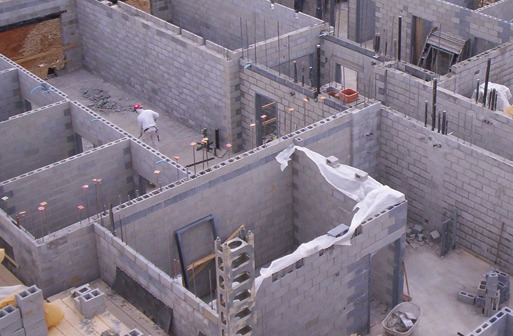Firewall (construction)
A fire wall (also fire rated wall, fire wall or fire wall) is a wall of separation or demarcation of fire zones. As a fundamental part of fire protection it is intended to prevent the spread of fire to other buildings or building sections. These are often at a wall of building, which was built on the property line or set halbscheidig also in Germany, a fire wall.
Likelihood of confusion with fire-resistant walls ( F 30 / F 60 / F 90). Unlike fire walls F- walls are only exposed to the flame during the test. Fire walls must after 90 minutes still withstand a defined impact. Have F- walls have a minimum thickness of 11.5 cm (depending on stone type, density class, type of mortar, with or without plaster ). Fire walls shall have a minimum thickness of 24 cm in general.
Requirements
A fire wall is made of non-combustible material ( = building material class A according to DIN 4102-1 ). In addition, it is designed in Germany that they at least 90 minutes a normalized fire resists ( = fire resistance class F 90 DIN 4102-2 or REIM 90 according to DIN EN 13501 ). This is to demonstrate on the basis of the classification according to DIN 4102-4 or a passed fire testing and obtaining an appropriate fire resistance class. An important part of this process is in Germany the existence of a normalized shock loading, so that the fire wall even with complete destruction of an adjacent fire compartment is still sufficiently stable and not destroyed by the fire and falling components loses its function. It follows the level required by the building codes fire wall quality of at least 90 F -A M.
Fire walls can also be designed in F120 or F180 with increased demand, for example in industrial construction. However, the requirement arises usually not from the building regulations or subordinate legislation, but from the insurance industry. This wall is then referred to as a complex divider.
A fire wall is usually done at least 30 cm above the roof to prevent a fire spreading above the roof surface. Also note that even re-entrant angle in the outer wall and the inner corner must be secured against the spread of fire.
Fire walls shall not contain openings. However, if it is necessary for use of the building, appropriate fire barriers must be installed. So would a door in "T -90" ( at least 90 minutes fire resistance = fire resistant ) are executed. According to financial statements for windows, ducts, service shafts, etc. must be provided. Since a fire wall has the aim to prevent the spread of fire for a certain time, incorrectly performed openings in the fire wall would significantly weaken the fire compartment separation.
Mandatory installation
Fire walls are required if
- A building to be built so close to a property line that a flashover to adjacent property is possible ( in Germany usually when the distance of the building from the property line is less than 2.5 m )
Or
- A building is so large that a complete burn-off of the entire building can not be accepted ( in Germany usually longer for buildings with a building front as 40 m or greater than 22 m). In these cases, an internal fire wall is required.
The precise specifications governing building regulations of each country.
In large buildings, in which the function by internal fire walls being seriously affected, it is possible to prevent the complete burning by an automatic fire extinguishing system. For this purpose, a fire report is required that determines, among other things, the fire load and allows further measures to the elimination of fire walls.
Canadian housing
In the Canadian housing a solid wall is visible beyond the roof. In order for a rollover of structural damage, fire and smoke should be avoided on the side facing away from fire. The wall is visible through the roof and will fog up with steel plate to prevent the ingress of rain water.










